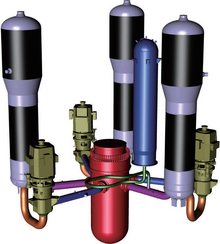Hualong One

The Hualong One, also known as Hualong-1 or HPR1000 (Chinese: 华龙一号; pinyin: Huálóng yī hào; lit. 'China Dragon №1'), is a Chinese pressurized water nuclear reactor design.[1]
The Hualong One is the most common reactor design under construction in China, and the mainstream technology in the near future. China also plans to export the reactor.[2]
Design
The Hualong One was developed by the China General Nuclear Power Group (CGNPG) and the China National Nuclear Corporation (CNNC) based on the ACPR1000 and the ACP1000 designs. Both are three-loop designs originally based on the same French M310 design.[3] In early 2014 it was announced that the merged design was moving from preliminary design to detailed design. Power output will be 1170 MWe gross, 1090 MWe net, with a 60-year design life, and would use a combination of passive and active safety systems with a double containment.[4]

Red line − active systems
Green line − passive systems
IRWST − in-containment refuelling water storage tank
Initially the merged design was to be called the ACC1000,[5][6][7] but ultimately it was named Hualong One.[2][4] In August 2014 the Chinese nuclear regulator review panel classified the design as a Generation III reactor design, with independently owned intellectual property rights.[8][9][10]
Construction
The first units to be constructed will be Fuqing 5 and 6, followed by Fangchenggang 3 and 4. There are five[11] Hualong One reactors planned for Pakistan, four reactors are planned at Karachi Nuclear Power Complex[12][13][14] and one reactor at Chashma Nuclear Power Plant, out of which two are under construction at Karachi.[15] Construction of another Hualong One reactor is planned to start in 2020 in Argentina.[16][17][18]
International marketing
In December 2015 China Guangdong Nuclear Power Group (CGN) and China National Nuclear Corporation (CNNC) agreed to create Hualong International Nuclear Power Technology Co as a joint venture to promote the Hualong One in overseas markets,[2] which was officially launched in March 2016.[19] On 19 January 2017 the United Kingdom Office for Nuclear Regulation (ONR) started their Generic Design Assessment process for the Hualong One, expected to be completed in 2021, in advance of possible deployment at the Bradwell nuclear power station site.[20] On 16 November 2017 the ONR and the Environment Agency announced they are progressing to the next phase of their Generic Design Assessment of the UK HPR1000 reactor. Step 2 formally commenced on this day and is planned to take about 12 months. The targeted timescale for the UK HPR1000 GDA process is about five years from the start of Step 1.[21]
See also
References
- ^ "Advanced Nuclear Power Reactors | Generation III+ Nuclear Reactors". World Nuclear Association. Retrieved 31 May 2018.
- ^ a b c "Chinese firms join forces to market Hualong One abroad". World Nuclear News. 31 December 2015. Retrieved 6 February 2016.
- ^ "Nuclear Power in China". World Nuclear Association. 24 September 2013. Retrieved 30 September 2013.
- ^ a b c Ji Xing, Daiyong Song, Yuxiang Wu (March 2016). "HPR1000: Advanced Pressurized Water Reactor with Active and Passive Safety". Engineering. 2 (1): 79–87. doi:10.1016/J.ENG.2016.01.017.
{{cite journal}}: CS1 maint: multiple names: authors list (link) - ^ "CGN Chairman He Yu Makes Proposal for Promoting Export of China-designed Nuclear Power Technology ACC1000". CGN. 6 March 2014. Archived from the original on 8 April 2014. Retrieved 7 April 2014.
- ^ "Nuclear Power in China". World Nuclear Association. April 2014. Retrieved 7 April 2014.
- ^ Caroline Peachey (22 May 2014). "Chinese reactor design evolution". Nuclear Engineering International. Retrieved 23 May 2014.
- ^ "China's new nuclear baby". World Nuclear News. 2 September 2014. Retrieved 9 March 2015.
- ^ "Independent Gen-III Hualong-1 reactor technology passes national review". CGN. 22 August 2014. Archived from the original on 2 April 2015. Retrieved 9 March 2015.
- ^ "Construction cleared for China's first Hualong One units". World Nuclear News. 16 April 2015. Retrieved 19 April 2015.
- ^ "中国为巴基斯坦建5座核反应堆 投150亿美元-新华网". Xinhua News Agency. Retrieved 4 July 2018.
- ^ China commits $6.5 billion for nuclear power project in Karachi
- ^ Local Fallout From Pakistan's Nuclear Energy Bet
- ^ Construction cleared for China's first Hualong One units
- ^ China ‘to build third Hualong One nuclear reactor’ in Pakistan
- ^ "Hualong One selected for Argentina". World Nuclear News. 5 February 2015. Retrieved 9 March 2015.
- ^ Charlie Zhu and David Stanway (6 March 2015). "'Made in China' nuclear reactors a tough sell in global market". Reuters. Retrieved 9 March 2015.
- ^ "Argentina and China sign contract for two reactors". World Nuclear News. 18 May 2017. Retrieved 19 May 2017.
- ^ "Hualong One joint venture officially launched". World Nuclear News. 17 March 2016. Retrieved 17 March 2016.
- ^ "UK GDA reports good progress for AP1000 and UK ABWR". Nuclear Engineering International. 23 March 2017. Retrieved 28 March 2017.
- ^ "Regulators start technical assessment of UK HPR 1000". world-nuclear-news.org. Retrieved 2017-11-17.
